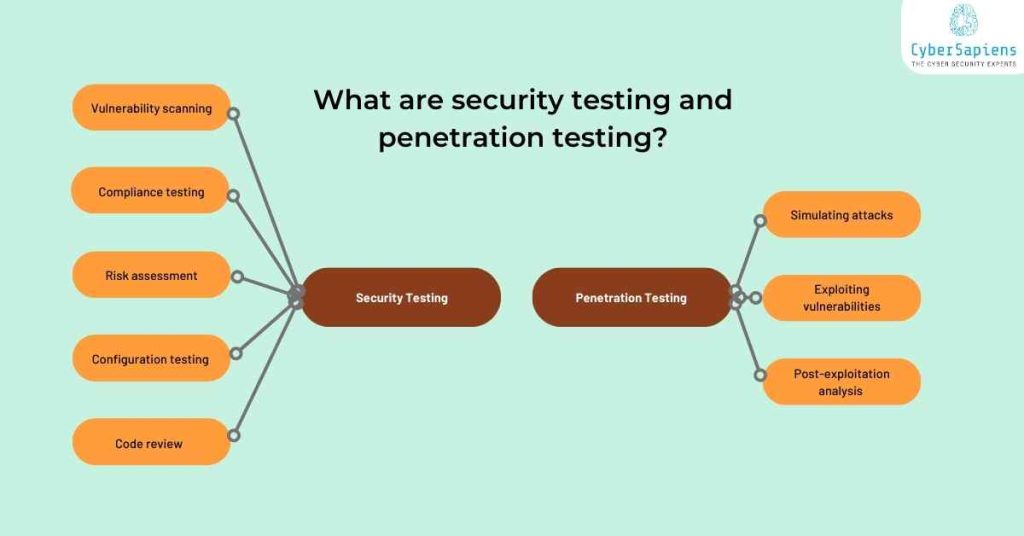Cybersecurity is an important issue in today’s world as companies and organizations of all kinds are aware of it. Today, cyber threats are on the rise, and this calls for a need to safeguard your digital assets from such risks. Two main approaches that are commonly utilized in this regard are Security Testing and Penetration Testing also known as Pentesting.
Though both are employed to establish the weaknesses and strengthen the security, they differ in their purpose and result.
In this article, we are going to discuss the Security Testing vs Pentesting: 10 Major Differences You Must Know.
But before going into the main topic let’s see what are security testing and penetration testing.
What are Security Testing and Penetration Testing?

Here it is we know that you eagerly wanted to know about Security Testing vs Pentesting: 10 Major Differences You Must Know. But before delving into the main topic you must know what security testing and penetration testing are:
1. Security Testing
Security testing is a kind of testing that is done to identify the vulnerabilities and threats existing in the system, application or even network. This reveals the effectiveness of the given system in terms of security and checks if the characteristics, policies and measures in place are sufficient and meet the required standard. Security testing is a broader approach that encompasses various aspects of security, including:
a. Vulnerability scanning
Identifying potential threats in the structures, connections and programs.
b. Compliance testing
It entails verifying systems and applications about the best practices, legal requirements, and organizational policies.
c. Risk assessment
The activity aims at evaluating the current situation to distinguish the factors that can cause some negative impact on it.
d. Configuration testing
Thus, making sure that the systems and applications are configured so that they will not present a threat.
e. Code review
The general idea of the process of identifying threats and potential vulnerabilities in the source code.
2. Penetration Testing
Penetration testing more commonly called pen testing or even ethical hacking is a security testing technique in which the application, system or network is attacked in a real-life scenario. The aim is to identify the vulnerabilities that an attacker can use to penetrate a system or an organization, acquire information or data or even paralyze an organization. Pentesting is a more targeted approach that involves:
a. Simulating attacks
In this case, they seek to bypass the security measures and look for a way to compromise the systems, data, and networks.
b. Exploiting vulnerabilities
The act of searching for and exploiting weaknesses in systems, applications and/or networks to gain access that is otherwise prohibited.
c. Post-exploitation analysis
To find out the extent of the attack on the system or network and what can be obtained from it.
Top 10 Major differences between Security Testing and Pentesting

Finally, let’s begin with our list of the Top 10 Major differences between Security Testing and Pentesting(Pen Testing).
| Difference | Security Testing | Pentesting |
| Objective | The key goal of this type of testing is to discover the strengths and the possible weaknesses of a system an application or a network and to check on the aspect of security requirements and policies. It is a more general approach that revolves around assessing the security status of an organization. | Conversely, the goal of Pentesting is to mimic an actual attack in the system, application, or network to check on the preparedness of the defences and to find out potential weaknesses that an attacker could use. Penetration testing is a more focused process that tries to establish certain vulnerabilities that may be exploited by the intruder to penetrate the system. |
| Scope | Security testing can be more general in the sense that it includes several sub-disciplines these include Network security, application security, data security and compliance. It involves assessing the security of an organization’s entire structure, its policies, and strategies. | Penetration testing is still a subset of this but it is much more specific and is used to determine the specific weaknesses that a potential attacker could use. It is a more specific type of attack that mimics a real-life scenario to challenge an organization’s defences. |
| Methodology | Security Testing can be of both automated and manual type and some of the techniques include vulnerability scanning, penetration testing and code review. It is a more formal way that is based on several rules and principles. | On the other hand, pen testing is the process that imitates a real-life attack on a system, application or network. It is a more active and innovative one, which implies a deep knowledge of the attackers’ approaches and strategies. |
| Tools and Techniques | There are various techniques and tools used in Security Testing, Some of which include vulnerability scanners, penetration testing tools, and code review tools. | Pentesting however, is a more specific and advanced branch of hacking that calls for the use of exploit frameworks, social engineering and post exploitationDumping. |
| Skillset | Security testing can be done by several people with general knowledge of security such as Security analysts, Penetration testers and Security engineers. | Pentesting, however, is a very specific branch that demands the understanding of programming languages, OS and networking protocols to list only the most fundamental. The pentesters on the other hand must also have a good grasp of the attackers’ ways and means. |
| Cost | Security Testing is generally less expensive than Pentesting, as it involves a more structured and automated approach. | Pentesting, on the other hand, is a more resource-intensive and time-consuming approach that requires a significant investment of time, money, and resources. |
| Frequency | Security Testing is typically performed regularly, such as quarterly or annually, to ensure ongoing compliance with security regulations and standards. | Pentesting, however, is often performed on an as-needed basis, such as when a new system or application is launched, or when significant changes are made to an organization’s security infrastructure. |
| Reporting | Security Testing typically generates a comprehensive report that highlights vulnerabilities, weaknesses, and areas for improvement. | Pentesting reports, on the other hand, are often more detailed and technical, providing a step-by-step guide on how an attacker could exploit identified vulnerabilities. |
| Compliance | Security Testing is often focused on ensuring compliance with security regulations and standards, such as HIPAA, PCI-DSS, and GDPR. | Pentesting, while also used to ensure compliance, is more focused on identifying real-world vulnerabilities that could be exploited by attackers. |
| Outcomes | The outcome of Security Testing is typically a list of vulnerabilities and weaknesses, along with recommendations for remediation and mitigation. | The outcome of Pentesting, on the other hand, is a deep understanding of an organization’s defences and a list of vulnerabilities that could be exploited by an attacker. Pentesting also provides a comprehensive understanding of an organization’s security posture and identifies areas for improvement. |
Useful Resources:
Here are some useful resources related to Penetration Testing:
- Top 50 Best Penetration Testing Tools
- Top 20 Best Network Penetration Testing Tools
- Difference between Red Teaming and Penetration Testing
- Advantages and Disadvantages of Penetration Testing in Cybersecurity
- Top 10 Android Penetration Testing Books for Complete Beginners
Conclusion
In conclusion, while both Security Testing and Pentesting are essential components of an organization’s cybersecurity strategy, they have distinct differences in their approach, objectives, and outcomes. Security Testing is a broader approach that evaluates an organization’s overall security posture, while Pentesting is a more targeted approach that simulates a real-world attack to identify vulnerabilities and weaknesses.
FAQs: Security Testing vs Pentesting: 10 Major Differences You Must Know
1. What’s the difference between security testing and penetration testing?
Ans: Security testing is a broad umbrella term encompassing various methods to identify weaknesses in systems and networks. Penetration testing is a specialized form of security testing that actively tries to exploit vulnerabilities, mimicking real-world attackers.
2. Which one should I choose between Security Testing and Penetration Testing?
Ans: Security testing is a good starting point for a broad security checkup. Penetration testing is ideal for a deeper analysis and understanding of how attackers might exploit your system.
3. Is security testing automated?
Ans: Security testing often utilises automated tools for efficient scanning. Penetration testing, however, is a more manual and in-depth process performed by skilled professionals.
4. Which one provides more detailed reports?
Ans: Penetration testing reports go beyond listing vulnerabilities. They explain how they were exploited, potential impacts, and specific remediation steps. Security testing reports primarily list vulnerabilities with general recommendations.
5. Do I need any technical expertise to perform security testing?
Ans: Security testing tools can often be operated with moderate technical knowledge. Penetration testing, on the other hand, requires a high level of expertise in cybersecurity vulnerabilities and hacking techniques.
6. How often should I conduct these tests?
Ans: Security testing, especially automated scans, can be done frequently. Penetration testing is typically conducted periodically, but organizations can benefit from more frequent assessments of critical systems.
7. Are these tests mandatory?
Ans: Security testing might be mandated by industry regulations for compliance. Penetration testing is not always mandatory but highly recommended for organizations handling sensitive data or wanting a proactive security posture.
8. What’s the cost difference?
Ans: Security testing, especially automated tools, is generally faster and more cost-effective than penetration testing due to the manual effort involved in the latter.
9. Do these tests focus on prevention or detection?
Ans: Security testing is crucial for preventive security by identifying vulnerabilities beforehand. Penetration testing helps with both prevention and detection by revealing attacker tactics and improving response capabilities.
10. Do these tests require access to the system’s internal workings?
Ans: Security testing can be performed with or without internal access (white-box vs. black-box testing). Penetration testing often utilizes both approaches, attempting to exploit the system from an external perspective even with some internal knowledge.












